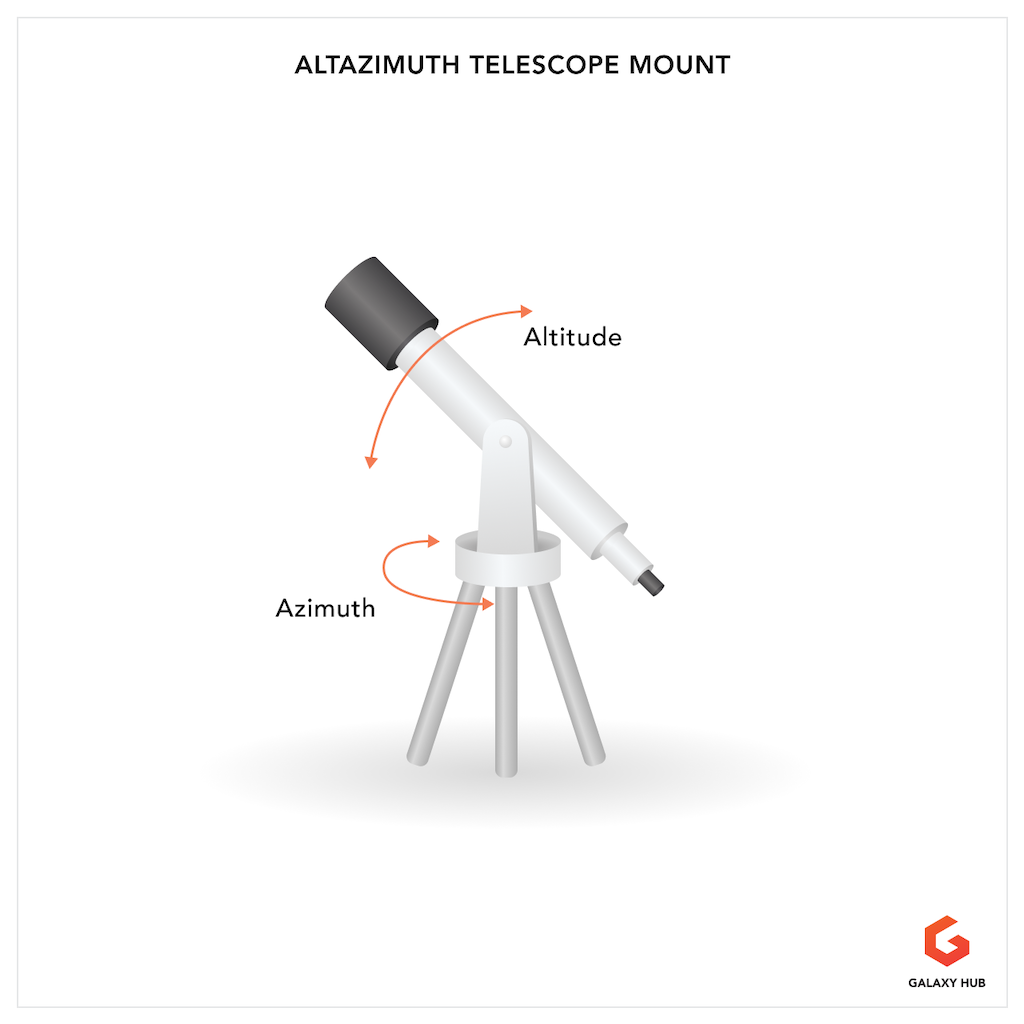What Is an Altazimuth Mount?
Before we go any further, it might be worth clearing up some confusion. If you’re a regular reader of astronomy magazines and/or online content, you’ve probably seen the word altazimuth written several ways. Firstly, you might have seen it as it’s written here; altazimuth. However, you’ve probably also seen it hyphenated; alt-azimuth.
So which one is correct?
The truth is, since neither one is definitive, they both are. Some might say that alt-azimuth is correct, since it means “altitude and azimuth” (more about that in a moment.) However, altazimuth is the more common version, with even the Oxford English Dictionary and dictionary.com providing definitions.
In this article, right or wrong, since altazimuth is the most common (and has the approval of the Oxford English Dictionary!), we’ll be using that convention throughout.
So now we know how to write it, what is it?
The short answer is that an altazimuth mount allows your telescope or binoculars to tilt vertically (altitude) and rotate horizontally (azimuth) – or to put it more simply, up and down and left and right!
The terms altitude and azimuth relate to an object’s position in the sky, and both are measured in degrees.
Altitude is how high above the horizon an object is, from zero to ninety degrees. An object at zero degrees is on the horizon and is therefore either rising or setting. An object at ninety degrees is directly overhead, at the zenith.
Azimuth specifies the object’s position in relation to the four cardinal points, north, east, south and west. If you were to face due north and then turn to the east, south, west and then north again, you’d turn 360 degrees. With that in mind, an object with an azimuth of 0 degrees is due north, 90 degrees is east, 180 degrees is south and 270 degrees is west.
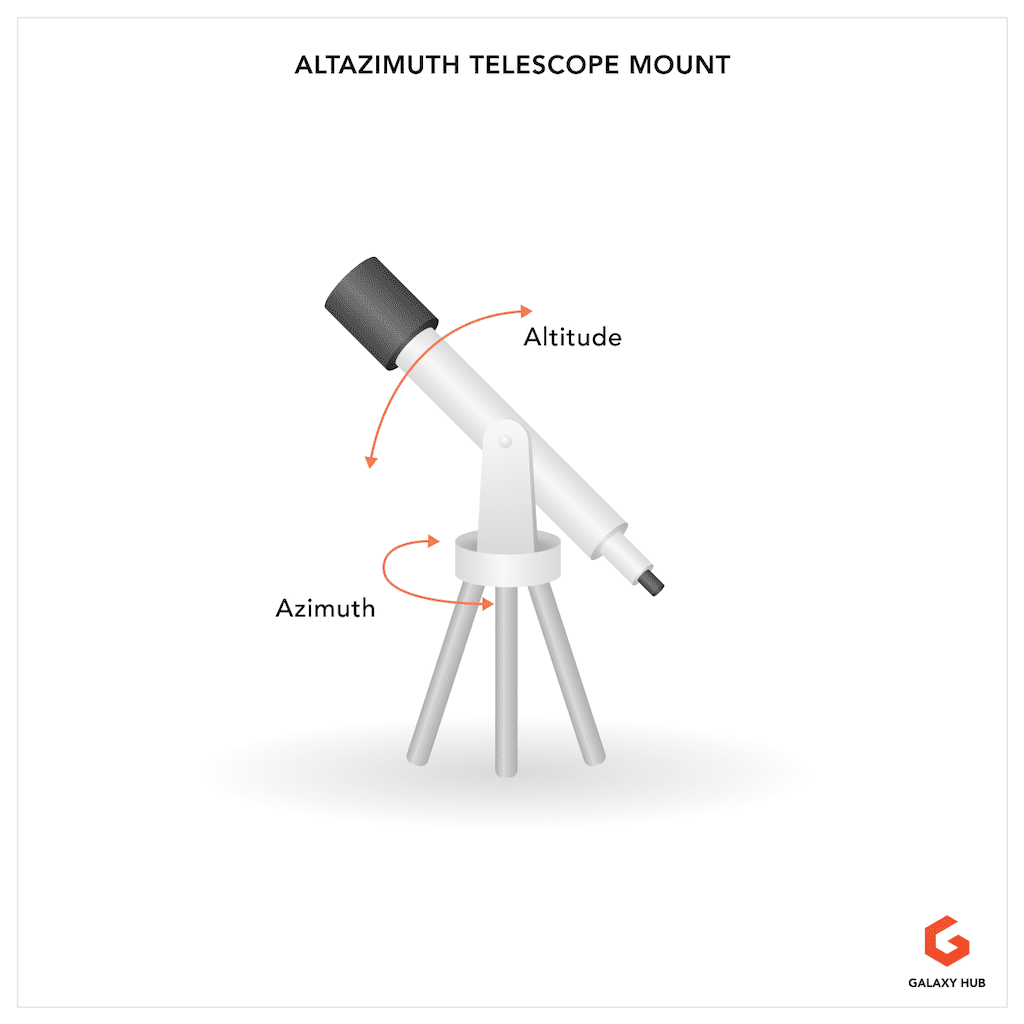
The Two Types of Altazimuth Mount
Altazimuth mounts effectively come in two varieties: the traditional tripod-based fork mount and the Dobsonian mount.
The chances are you’re already familiar with tripod-based fork mounts. The tripod has three legs that, in most cases, can be extended or retracted to suit the height of the observer. Tripods also tend to have an accessory tray that sits between the three legs and allows you to keep your eyepieces and filters within easy reach.
The telescope itself is attached to the tripod with a fork mount that’s attached to the tripod. The fork mount is actually more Y or U-shaped than anything else, with two “prongs” that hold the telescope tube in place.
Tripod-based fork mounts can be used with refractors, reflectors and hybrids.
The other type of altazimuth mount, the Dobsonian, is a relatively new invention that can only be used with reflector telescopes. Essentially, it’s like a tripod-based fork mount without the tripod. The mount has a circular bottom that sits directly on the ground and rotates, allowing the telescope to move in a left/right (azimuth) motion.
Similar to a tripod-based fork mount, there are two tall sides attached to the base, which act like prongs and hold the telescope tube in place. These also allow the telescope to move in an up/down (altitude) motion.
Since there’s no tripod involved, the accessories are typically stored on a small rack on the side of the mount.
Perhaps the biggest advantage of a Dobsonian is its sturdiness. A tripod can potentially be a little shaky and there’s always the potential of tripping over a leg in the dark!
One other difference is that you don’t tend to disassemble a Dobsonian unless you’re transporting the scope to a new location. When it comes to tripod mounts, the telescope is often detached and the tripod legs are retracted for storage, but that’s not typically the case with a Dobsonian.
With that in mind, if you’re short on space or intend to drive to a dark location, and you don’t mind re-assembling the telescope for each observing session, then a tripod might be preferable. If, on the other hand, you want to “set it and forget it” then a Dobsonian might be the better choice.
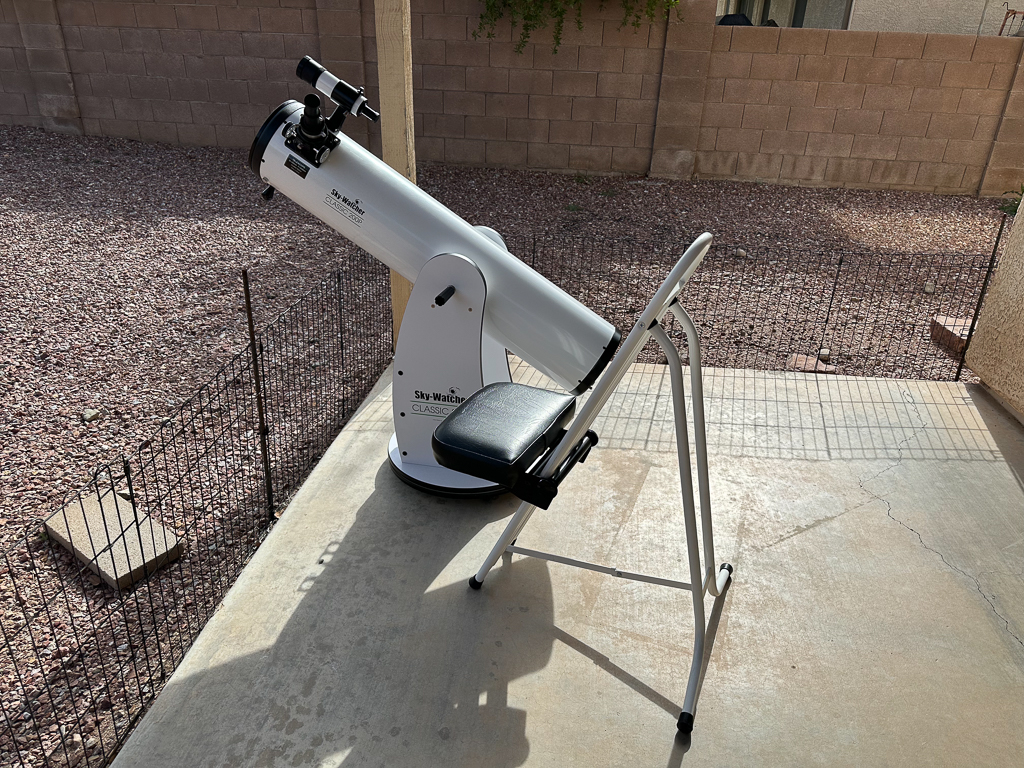
How Do You Use an Altazimuth Mount?
Using an altazimuth mount couldn’t be simpler. Once you’ve assembled the scope, you only need to move it by turning it to the left and right, or by tilting it up and down. This makes it super-easy to aim your telescope toward your target.
However, altazimuth mounts have one major drawback: they don’t follow the path of your target across the sky.
Unless you live at the north or south pole, any and every celestial object will rise over the horizon at an angle and then set below the horizon at an angle.
The problem that altazimuth mounts have is that they’re not tilted at that angle. The telescope can move up and down, and left and right, but that’s not how celestial objects move.
Let’s image you’re looking at the setting crescent Moon with a regular refractor on an altazimuth tripod. You may have centered the Moon in your field of view, but as the minutes go by, the Moon is setting. It’s sinking at angle toward the horizon, so you’ll see the Moon move – at that same angle – across the field of view.
Eventually, after a few minutes, it will move out of your field of view completely. You’ll therefore need to move your scope a little to the right and then down a little to keep the Moon centered.
That said, many tripod-based refractors will also have knobs that will allow you to make fine adjustments, which can be useful for keeping your target in view, but Dobsonians lack this feature.
(It’s not a major inconvenience, it just means you have to be a little more careful when you realign your scope, as even the smallest movement will seem to have a big effect through the eyepiece.)
Want to get started in astronomy?
Our free telescope cheat sheet breaks down the key factors to choosing a telescope and shows you how to get stunning views of planets, nebula, and galaxies!
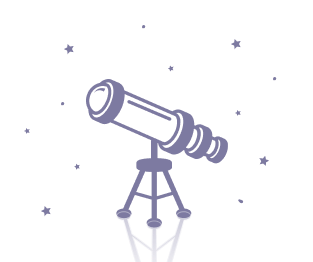
Computerized Altazimuth Scopes
One solution is a GoTo scope. This is a computerized scope that can find and track your targets for you. It has a hand-controller with a built-in database containing information on thousands of deep sky objects. From this, it can make recommendations and then use its drive motor to point the telescope toward your target. Better yet, it will automatically track your target for you.
While this sounds ideal for beginners, you’ll still need to align the scope with two or three bright stars or planets before each observing session. This is easy with an altazimuth mount, as you can use the GoTo’s hand controller to move the scope, as well as make fine adjustments. However, if you’re completely new to the hobby, you may not know which stars to use for the alignment.
The downside is that GoTo scopes tend to be more expensive than a regular scope, but Celestron’s range of StarSense scopes is looking to change this. It’s basically a middle-ground option; there’s no motor or built-in computer, but you can attach your smartphone to the telescope and Celestron’s StarSense app will guide you to your target.
This is how it works: the app displays arrows to show you in which direction you need to aim your scope. As you turn and tilt your scope, the app updates its directions in real-time, until it indicates that your scope is pointing toward your target. When that happens, all being well, your target should appear within your eyepiece field of view.
Since it has no motor drive, it’s unable to track your target as it rises and sets, so you’ll still need to make manual adjustments as you observe.
Altazimuth vs Equatorial – Which is Better?
As mentioned earlier, the big drawback to altazimuth mounts is that, unless you have a motorized telescope, you won’t be able to track your target with an altazimuth mount.
Equatorial mounts are tilted to match the angle that targets rise and set from your location. This makes it easy to track your target, as you only need to turn your telescope to the left or right in order to track it.
Since astrophotography requires you to track your target for a period of time, equatorial mounts (provided they are motorized) or a GoTo altazimuth are a necessity.
If, however, you only need your scope for visual astronomy, then a regular altazimuth scope will do the trick, especially if you’re a beginner.
Equatorial mounts require more work to set up and they can be confusing for beginners. On the other hand, regardless of whether you have a tripod or a Dobsonian base, you’ll find altazimuth mounts to be the simplest and easiest to use, which is why many beginners are advised to start with an altazimuth rather than an equatorial.
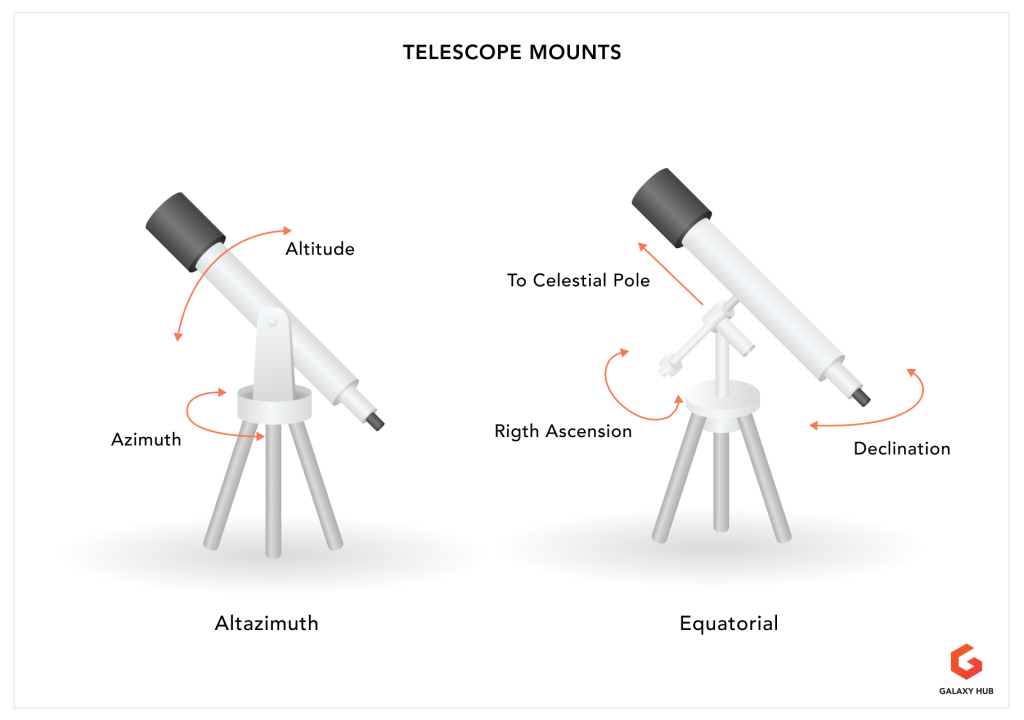
How to Choose a Good Altazimuth Mount
Seek Advice
Regardless of whether you’re buying a new telescope, or are looking to buy a replacement mount, bear in mind that it’s not always possible to try before you buy! Be sure to read the reviews from the sites of reputable equipment retailers, such as High Point Scientific or OPT Corp to get an idea of what other users think.
Also consider joining an astronomy group, either locally or online. In both instances, you’re sure to meet experienced folk who can give you plenty of advice and help to ensure you get the right mount for your needs. Visiting a local group also has one major benefit over online groups: you can potentially try the equipment before you hand over your hard earned cash!
Dobsonian mounts are designed to be sturdy, but when it comes to tripods, be sure to consider the construction of the mount. Generally speaking, you want something solid that’s not easily knocked over, and you should probably avoid plastic tripods for that reason. Wooden tripods can be a good choice, but they can be hard to find, leaving you the option of aluminum or stainless steel. Of the two, stainless steel is typically heavier and stronger, but aluminum is often cheaper.
Understand Your Requirements
If you’re looking to replace the mount of a scope you already own, you should make sure you have the right information beforehand. Specifically:
- The number of forks needed. Is it held in place by one fork or two?
- The type of mounting bars you need. Do you need a Losmandy or Vixen style dovetail bar?
- The weight of your equipment. Can your new mount support the weight of the telescope and accessories?
If you’re not sure, check the user manual (they can often be downloaded from the manufacturer’s website as a PDF) or call the customer service line of either the manufacturer or the retailer. For example, both OPT Corp and High Point Scientific have experts on-hand you can talk to.
Want to get started in astronomy?
Our free telescope cheat sheet breaks down the key factors to choosing a telescope and shows you how to get stunning views of planets, nebula, and galaxies!

What Are the Pros and Cons of an Altazimuth Mount?
If you’re a beginner, it’s hard to go wrong with an altazimuth mount. You’ll find they’re easy to set up and use, as you only need to turn the telescope to the left and right, or tilt it up and down. Unfortunately, that’s also its biggest downfall – since the mount isn’t angled to match the rising and setting of celestial objects, altazimuth mounts make it difficult to track your targets.
This also means they’re not suitable for astrophotography, as a long exposure is required to capture the image, and without tracking a long exposure simply isn’t possible.
Computerized scopes, such as GoTos, solve this problem by automatically locating and tracking the object, but they tend to cost more than a manual mount and are usually tripod based.
Dobsonian mounts are sturdy and solid, but they’re usually heavier as a result. They’re typically designed to be assembled and then left as-is, which means you’ll need a little more space for storage and they can sometimes be difficult to transport.
Most amateur astronomers start with a manual altazimuth mount as they’re very easy to use. Some will then move on to a computerized GoTo, or learn to use an equatorial mount for astrophotography. Either way, an altazimuth is a great starting point for young and old beginners alike, and as such, is frequently the telescope many of us started out with!
